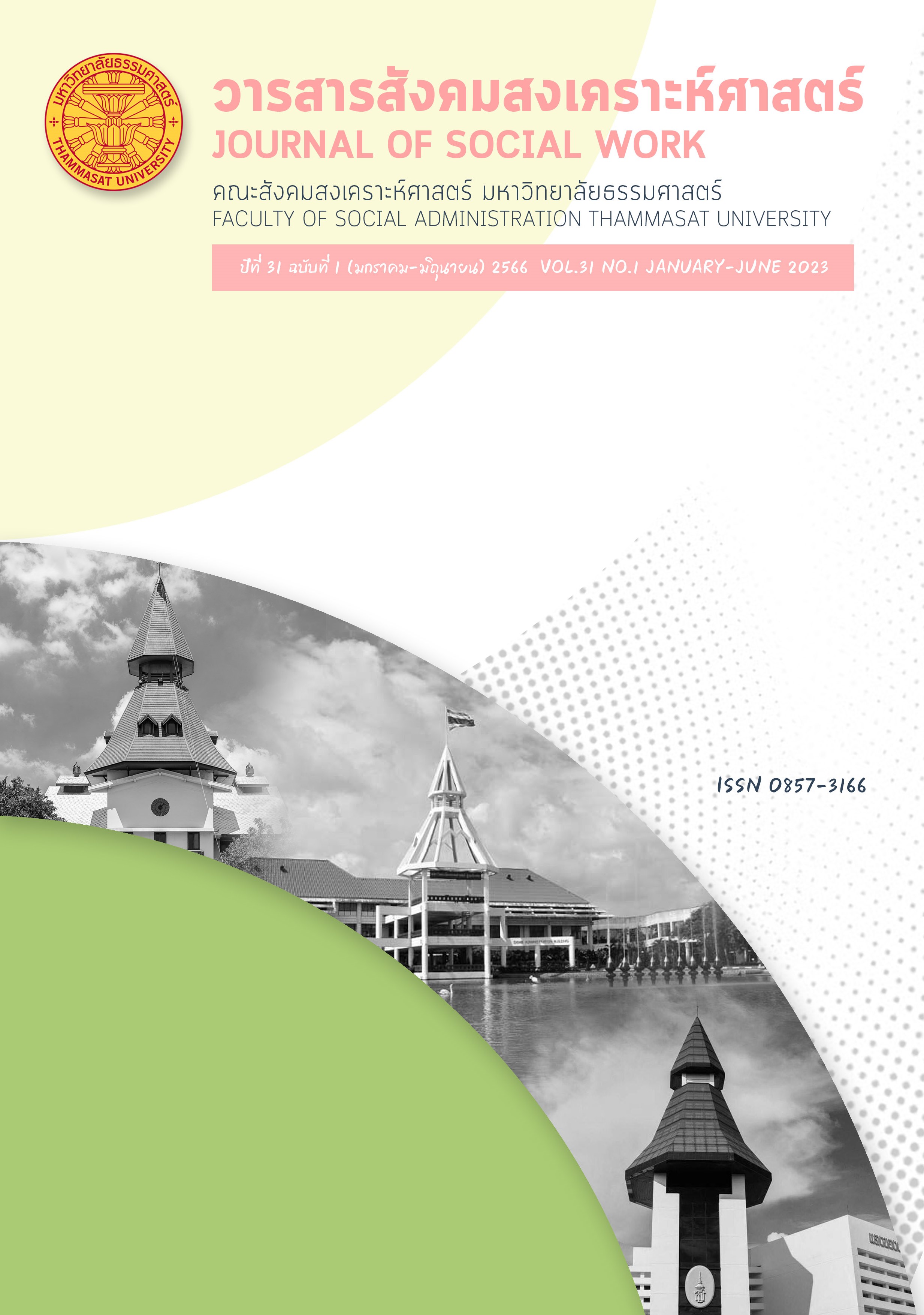People’s Attitudes Towards the National Defense Roles of the Royal Thai Armed Forces
Keywords:
Royal Thai Army, People's attitude, Roles and duties in The Royal Thai Armed ForcesAbstract
This research aims to study people's attitudes towards the roles and duties of the Royal Thai Armed Forces and study the relationship with the personal factors affecting people's attitudes towards these roles and duties. A research conducted was survey of people's attitudes towards the Royal Thai Armed Forces. A quantitative method was applied using questionnaire and open-ended questions as a tool to collect data concerning people’s attitude. The population included in this study were: people who are living in the area of the Army Region as specified as Regions 1, 2, 3, and 4. The sample group of 600 people were collected using a simple random sampling method. The research results showed that The Royal Thai Armed Forces received with the highest average at 3.7 for their actual performance. People attitude towards the Royal Thai Armed Forces focusing on their policy management, budget allocation, and personnel operations received an average of 3.66 while they have complaints management system and clarify the details of the operation to public received an average of 3.65. Attitude toward their transparency, fairness and non-discrimination management totaled 3.64 and Lastly, people attitude towards their have channels for all section to inspection and complain administration of the Royal Thai Armed Forces received an average of 3.59. In conclusion, people’s attitudes towards national defense roles in the protection of the monarchy as well as supporting missions gained the highest average satisfaction level at 4.1. People’s satisfaction towards the protection of democracy came next with an average score of 4.06. However, the study found that the people satisfaction over the Royal Thai Armed Forces in terms of policy management, budget allocation, and personnel practices was at the lowest level. In order to develop guidelines to increase people's positive attitudes towards the Royal Thai Armed Forces the following are recommended: 1. Creating greater transparency in the operation 2. Enhancing innovation and expanding new knowledge development 3. Listening more to public voices.
References
กองบัญชาการกองทัพไทย. (2562). วันสถาปนากองบัญชาการทหารสูงสุด. กรุงเทพฯ: กองบัญชาการกองทัพไทย.
กองบัญชาการกองทัพไทย. (2563). แผนปฏิบัติราชการ 4 ปี กองทัพไทยและกองบัญชาการกองทัพไทย พ.ศ.2559-2562. สืบค้นจาก https://www.rtarf.mi.th/index.php/th/2016-06-23-07-14-52/2016-06-23-07-36-47/82-2018-01-16-04-42-52
กองบัญชาการกองทัพไทย. (2563). นโยบายผู้บัญชาการทหารสูงสุด ผู้บัญชาการทางทหาร ประจำปีงบประมาณ 2562. สืบค้นจาก https://www.rtarf.mi.th/index.php/th/2016-06-23-07-14-52/2016-06-23-07-36-45
ประยุทธ์ จันทร์โอชา. (2551). กองทัพไทยกับภัยคุกคามรูปแบบใหม่. กรุงเทพฯ: สมาคมรัฐศาสตร์แห่งมหาวิทยาลัยเกษตรศาสตร์.
สมพงษ์ นาคทอง, พล.ร.ต. (2560). เทคโนโลยีต่อต้านการก่อการร้ายในศตวรรษที่ 21. สืบค้นจาก http://www.dsdw2016.dsdw.go.th/doc_pr/ndc_2560-2561/PDF/8547st/8547%E0%B8%9E%E0%B8%A5%E0%B9%80%E0%B8%A3%E0%B8%B7%E0%B8%AD%E0%B8%95%E0%B8%A3%E0%B8%B5%20%E0%B8%AA%E0%B8%A1%E0%B8%9E%E0%B8%87%E0%B8%A9%E0%B9%8C%20%E0%B8%99%E0%B8%B2%E0%B8%84%E0%B8%97%E0%B8%AD%E0%B8%87.pdf
Bonn, K. E. & Anthony E. B. (2000). Guide to Military Operations Other than War: Tactics, Techniques, and Procedures for Stability and Support operations, Domestic and International. Mechanicsburg, Pennsylvania: Stackpole Books.
Curt, N. (2015). Public Opinion and the Military: A Multivariate Exploration of Attitudes in Texas. Journal of Political and Military Sociology: An Annual Review, 75-105.
Dawes, M. (2008). UNREASONABLE FORCE. Retrieved from https://www.amazon.co.uk/UNDERSTANDING-UNREASONABLE-FORCE-Dawes-2008-01-03/dp/B01K92Q7FK
Katz, D. (1960). The Functional Approach to the Study of Attitudes. Princeton University.
Murphy, G., Murphy, L., & Newcomb, T. (1973). Attitude. Retrieved March 9, 2011, Retrieved from http://www.novabizz.com/NovaAce/Attitude.htm
Norman L. M. (1971). Introduction to Psychology. Boston: Houghton Miffin.
OECD. (2020). OECD Economic Surveys Economic Assessment. Retrieved from https://www.oecd.org/economy/surveys/Economic-assessment-thailand-overview-2020.pdf
Public Sector Economics. (2018). Introduction to the Public Sector Economics 2018 Conference – Fiscal Openness: Transparency, Participation and Accountability in Fiscal Policies. Retrieved from http://www.pse-journal.hr/en/archive/introduction-to-the-public-sector-economics-2018-conference-fiscal-openness-transparency-participation-and-accountability-in-fiscal-policies_3880/
William, C. S. (2017). Communicating to lead and motivate. Business Expert.
Rita, P. (2012). Resilience as a Policy Response to Non-Traditional Security Threats. University of New South Wales, Australian.
Sackett, P. R., & Mavor, A. S. (2003). Attitudes, Aptitudes, and Aspirations of American Youth: Implications for Military Recruitment. Washington, D.C.: National Academies Press.
Samuel. P. H. (1957). The Soldier and the State. Cambridge: Harvard University Press.
Sarigil, Z. (2015). Public Opinion and Attitude toward the Military and Democratic Consolidation in Turkey. Armed Forces & Society, 41(2), 282-306.
Taw, J. M. (1999). Planning for Military Operations Other Than War: Lessons from US Army Efforts. Australian Defence Force Journal, 134, 57–68.
Downloads
Published
How to Cite
Issue
Section
License
Copyright (c) 2023 Journal of Social Work

This work is licensed under a Creative Commons Attribution-NonCommercial-NoDerivatives 4.0 International License.
The manuscripts published in the Social Work Journal is the copyright of the Social Work Journal, Thammasat University
Any article or opinion appeared in the Social Work Journal will solely be under the responsibility of the author The Faculty of Social Administration, Thammasat University and the editors do not need to reach in agreement or hold any responsibility.



